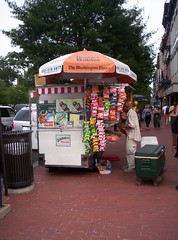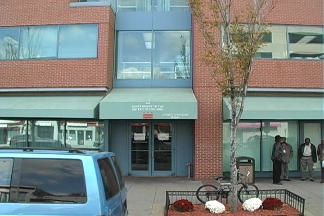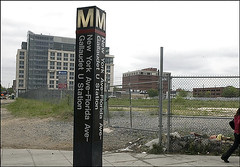How the Growth Machine promotes DC intra-city sprawl

The Washington Business Journal, in their editorial "A New Lease" in the 4/13-19/2007 issue writes that DC Government faces a challenge because over the next three years, 41% of the property leases the city holds will expire and that the city faces potential lease price increases of up to 51%.
Therefore, the editorial argues that moving agencies around to "less-expensive parts of the city" is an "opportunity."
1. Why sell city properties so often, if the city leases so much property?
2. Moving offices around the city, to less expensive places, has other costs including inducing intra-city sprawl and an inefficient utilization of the transportation infrastructure.
3. Not to mention the deliberate diminishment of the agglomeration economies that arise from propinquity.
Plus, for a variety of reasons, moving office workers around isn't the kind of "jump start" to neighborhood revitalization that Growth Machine types including business newspapers and journalists believe.
Office workers have limited needs, food and service retail, and you need many many workers to have any sort of substantive impact, especially on retail.
A typical office worker supports 2 square feet of retail and 5 square feet of restaurant space.
My joke for many years about the locating of DC DOES and DC DHS offices is that the economic effect was one to two hot dog vendor carts. (It started with two but dwindled to one.) No substantive support of local business (other than resale of food stamp benefits and related entrepreneurial efforts) ever really obtained.

DC Department of Health at 641 H Street NE
At best the 600 workers would have supported 1,200 s.f. of retail--one store--and eventually even the CVS moved--and 3,000 s.f. of restaurant--although that never happened.
Plus people drove to work, not riding the subway, and definitely not riding the X or D or 90s buslines. So the city paid for parking for the employees, rather than having them get to work on their own.
Part of it too is perception, as the Post reported in this short, "EEOC Is Moving On; Fast Food and a Dicey Neighborhood Await," workers often look askance at having to work in revitalizing places. The caption of the photo accompanying the article states "Some at the Equal Employment Opportunity Commission fail to see the upside of moving from downtown Washington to Northeast. The new headquarters' neighbors will include 'one of the largest open-air drug markets in the region'" and the article doesn't get much better:
The Equal Employment Opportunity Commission is in an uproar over a decision by Chair Naomi C. Earp to move its 500-employee headquarters from fine offices in downtown to a "developing" -- but not quite arrived -- area in desolate Northeast near the old Woodie's warehouse on New York Avenue.
At a hostile meeting yesterday to quell a growing rebellion, Earp told several hundred employees -- and others viewing on closed-circuit television -- that "the determining factor is price" in her decision and that employees "should not overreact to concerns about safety."

Empty lot at 131 M Street NE. Photo by Kevin Clark, The Washington Post. I will say that H Street had this kind of feel back when DOES and DHS moved to H Street in the late 1980s.
I mention the Growth Machine, because as the abstract of the paper, "City as a Growth Machine: Toward a Political Economy of Place," states:
A city and, more generally, any locality, is conceived as the areal expression of the interests of some land-based elite. Such an elite is seen to profit through the increasing intensification of the land use of the area in which its members hold a common interest. An elite competes with other land-based elites in an effort to have growth-inducing resources invested within its own area as opposed to that of another. Governmental authority, at the local and nonlocal levels, is utilized to assist in achieving this growth at the expense of competing localities. Conditions of community life are largely a consequence of the social, economic, and political forces embodied in this growth machine. The relevance of growth to the interests of various social groups is examined in this context, particularly with reference to the issue of unemployment.
Labels: agglomeration economies, Growth Machine, intra-city sprawl, sprawl, urban revitalization



0 Comments:
Post a Comment
<< Home